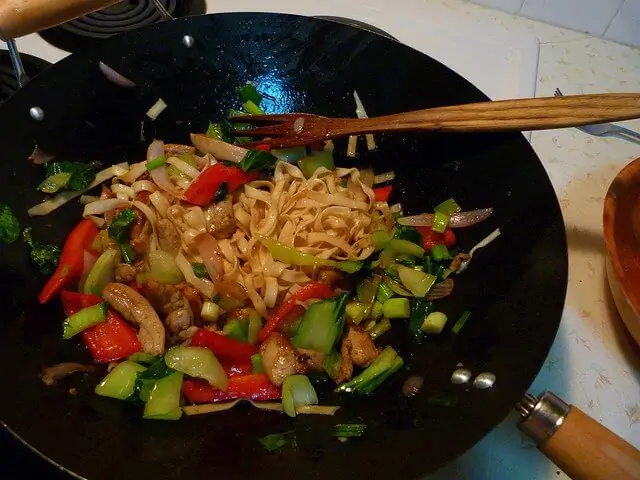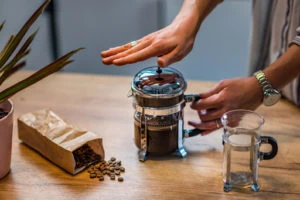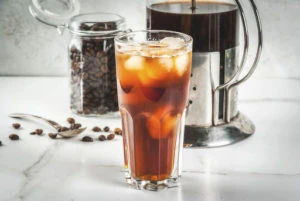Asian cuisines are among the healthiest in the world. Low in fat, Asian cooking involves lots of vegetables and seafood. Red meat is used sparingly and as a flavoring rather than as the main event. If you’re tired of calling for take-out whenever you crave Asian food, then getting a carbon steel wok and trying your hand a something new might just be the ticket!
Asian stir-fry is a quick and easy way to cook. All you really need are a couple of specialty sauces (available in most supermarkets), some vegetables, and a protein. And if you’re feeling particularly lazy, many vegetables come pre-cut in your supermarket’s produce section or salad bar.
Stir-fry cooks quickly because woks are designed to cook foods for short periods at searingly high temperatures. Woks are versatile as well. Not only can you use your wok for stir frying, but you can also use it for frying, deep frying, boiling, braising, poaching, steaming, stewing, smoking, and even for making an omelet or roasting nuts.
With a carbon steel wok, you can still order take-out if you really want to, but you will also have the option of making your own Asian meals at home.
Check out my favorite wok setup. The Eastman Outdoor Wok at Amazon is a home run for any household that enjoys cooking outdoors. The best part is, you can find it at Amazon RIGHT NOW, and it’s practically a steal.
| Best Carbon Steel Woks | Best Features |
|---|---|
| 1. Le Creuset Enameled Cast Iron Signature Wok | flat base works with all stovetops; comes in two colors |
| 2. Joyce Chen 21-9978, Classic Series 14 Inch Carbon Steel Wok | carbon steel is safe for gas, electric, and induction stove tops; birch wood handles stay cool |
| 3. Gold Tulip Carbon Steel Wok with Flat Bottom | flat bottom can be used on gas and electric stovetops and grill; wooden handle helps you control wok while cooking |
| 4. KEN HOM Carbon Steel Wok | smaller size good for smaller households; comes with 10-year guarantee |
| 5. Craft Wok Heavy Hand Hammered Carbon Steel Pow Wok with Wooden and Steel Helper Handle | conducts heat well; textured to prevent food from pooling in bottom |
| 6. Eastman Outdoors Gourmet 22-inch Wok Kit | great for camping or using outside; comes with spoon, spatula, propane burner with gas regulator, and adjustable legs |
| 7. Helen Chen’s Flat Bottom Wok With Lid | flat bottom works on traditional stovetops; includes domed lid |
| 8. Cook Pro Professional Lightweight Wok | gorgeous matte finish and wooden handle; flat bottom works on traditional stovetops |
A little context
If you think you can just toss a bunch of ingredients into a regular frying pan and a 5-star stir-fry dish will magically appear right before your eyes, you’re going to want to pull up a chair.
For thousands of years, the Chinese have used a rounded cooking surface called a wok. In Cantonese, the word “wok” means “cooking pot.” Most Asian cultures use woks as their main cooking utensil. In Japan, the word for wok translates to “Chinese pot.” In other Asian cultures, woks are known as Kuali. Indian culture also uses a wok. The word for which (like the Japanese) also translates to “Chinese pot!”
Earliest woks
The first known woks appear in Han Dynasty tombs, as small terracotta versions on top of small terracotta stoves (like the ancient Egyptians, Han royalty went off into the next world prepared with all the things they would need for the afterlife). Scholars agree, though, that the Han may have borrowed the wok from an earlier culture.
Two reasons the wok became a pervasive cooking pot are; they require very little fuel to cook in, and that they were versatile.
Transformation of the wok
In recent years, the wok has been refined and modified to fit the needs of the modern-day cook. A 21st-century wok is a lot more user-friendly than the massive, rounded cooking bowls used in the Han Dynasty. Thankfully, many wok models have retained the best features of their aged counterparts.
What makes a wok so special?
A wok is a wide, bowl-shaped cooking surface that lets the chef cook meat and vegetables with an even distribution of heat. Traditionally, woks were made of carbon steel or cast iron. Now, woks can also be found in aluminum and stainless steel, with or without a nonstick coating. We do not recommend these materials.
The tall, flared edges of a wok are meant to keep your ingredients from jumping out of the side of the pan when you attempt to toss the contents. These tall edges ensure you don’t find half of your dinner on the floor instead of in the pan! The tall edges also give you more cooking space for searing ingredients. If you are browning meat, you can arrange it in a single layer almost to the edges of the wok, giving you more surface area than in a modern saute pan.
Traditionally, woks were always rounded. They were meant to sit in the coals of a fire. Newer models are often forged with a flat bottom to accommodate Westernized cooking surfaces. The flat surface ensures the pan won’t topple over if you leave it unattended.
A word on cooking surfaces
Back in the old days (before the modern stove was invented), woks were meant to be nestled into the coals of a fire. Most of the outside surface of the vessel was in direct contact with the heat source. Cooking with a wok is equated with very high temperatures and also why woks are very economical in their use of energy – the cooking happens very fast, and the fire does not need to be fed as it does for longer cooking methods.
Take a culinary tour…
Next, I’ll show you how to make your own curry powder.
Usually, the woks produced today are made with flat bottoms to accommodate modern stoves. These will work on gas or propane ranges, electric coils, and flat-top stoves with halogen burners. These pans work well, but they will never get as hot as you would like them to. If you need to buy a flat-bottomed wok for this kind of stove, I recommend that you buy a cast iron wok. Although cast iron cookware is quite heavy (you won’t be able to flip the food in the pan with a simple flick of your wrist) it gets hotter and stays hotter, better approximating true wok cooking.
Le Creuset Enameled Cast Iron Wok
If you have a gas or propane stove, you can remove the cast iron grate and use a wok ring that (sometimes) comes with your pan. This gets the wok a little closer to the heat source. This is a better option than the flat-bottomed wok. If you’re really, really lucky, and you have a high-end gas range like a Wolf or a Viking, you can get a cast iron wok ring accessory that is made for the stove. This is the closest that you will get to perfection in wok cooking!
Ever wondered which vegetable peeler was the best in the world?
Why should I choose a carbon steel wok over one made of other materials?
With no shortage of materials and options to choose from for your next wok, you’re probably wondering why you should choose a carbon steel wok over the other options. Electric, anodized aluminum, ceramic cast iron, and other nonstick surfaces are available. However, carbon steel does not release toxic chemicals when heated to a very high heat.
Carbon steel and cast iron are more similar than you think, both are made from iron and carbon but in different proportions. Carbon steel contains about 1 percent carbon while cast iron has 2 to 3 percent carbon. On paper, this looks almost insignificant, but it makes a world of difference. Both materials behave similarly when it comes to heat, but carbon steel is lighter and more pliable while cast iron is more brittle and heavier.
A carbon steel wok is also chip and crack-resistant, as it’s made from a durable metal. Even if woks made of other materials are less expensive than carbon steel, opt for the most expensive pan you can afford – fortunately, carbon steel cookware is relatively inexpensive – every wok being reviewed later in this article cost less than $50. Woks are meant to be used at very high heat, which can warp a cheap pan (this is a death knell if you have a flat-top stove). You’ll probably spend more money replacing a series of inexpensive woks than you would have if you’d purchased a quality carbon steel wok from the start.
Although carbon steel and cast iron share many of the desirable properties of a long-lasting cooking surface, carbon steel is the preferred material for your wok. Unless you really enjoy lifting heavy objects or have a flat-top stove, steer clear of a cast iron wok.
Find more recommendations for your kitchen… like this write up on the best butternut squash peeler.
Why not cast iron
You may be asking yourself: but why can’t I use cast iron, It conducts heat extremely well and retains that heat just as well?
Interestingly enough, the answer to that question actually lies within the question. That same heat retention that we typically adore cast iron for, is a detriment in this case.
When using a wok, heat retention is actually the opposite of what we are looking for. Wok cooking requires rapid heat changes and this is a quality that cast iron simply does not have. And having to wait 3 minutes every time you need to change the temperatures will ruin that smokey flavor synonymous with wok cooking.
Cooking with a carbon steel wok only gets better with time.
If you’ve ever cooked with cast iron, you know how seasoning the pan lets the flavors absorb into the cooking surface. The seasoning (also known as a patina) yields a depth of flavor that would be lost using a nonstick pan. See how to properly season cast iron.
KEN HOM suggests seasoning your wok as follows:
“The best way to season the wok is to scrub it clean, then wipe it dry and heat it over medium heat with two tablespoons of vegetable oil (not olive oil). With clean kitchen paper, rub the oil over the surface of the wok. Keep doing this every five minutes for about 20 minutes, until the kitchen paper comes out clean.”
Maintenance
To a modern-day cook, the thought of not washing a pan may fly in the face of reason. In truth, cast iron and carbon steel shouldn’t be exposed to soap! Cleaning your carbon steel wok should consist of a simple rinse with hot water, followed by a wipe with a sponge or wet cloth. If food does stick, a bamboo wok cleaning brush or a stainless steel cloth (the one I have resembles Medieval chain mail) can be used. See my recommendation of some good non-abrasive sponges.
Check out the Amagabeli chain mail scrubber at Amazon
When cooking with your carbon steel wok, many recipes will call for oil in the pan so that the ingredients do not stick to the cooking surface. Never use olive oil or any other oil with a low flashpoint in your wok. Another benefit of a carbon steel wok is that it requires less oil with each use and becomes more nonstick over time.
What features should a good carbon steel wok have?

Chances are you won’t be pulling out the wok to cook an Asian stir-fry for one. Asian cuisine is as much about being with others as it is about nourishment. Be sure to choose a wok that can accommodate the number of people that you plan on feeding. A big wok is great for cooking and entertaining.
If you’re not sure what size to get, the Wok Shop provides these recommendations:
- 12″ for up to 5 people
- 14″ for 6 to 12 people
- 16″ for over 12 people
For a big wok, I’d recommend choosing a model that has a wooden handle, as well as a helper handle on the other end of the wok. A wok that’s full and heavy will be difficult to lift by just one handle. The downside to wooden handles is that the high heat can damage the wood. Many Asian grocery stores, however, do sell replacement handles, and they are usually held in place by a screw or two.
As for the shape of your carbon steel wok, choose one that isn’t too shallow. Ensure that it has a wide enough base so that it won’t topple over on your range. If a wok is too narrow, heat won’t be distributed evenly, which could affect the quality of your stir-fry.
Utensils
Now that you’ve decided to venture into wok cooking, make sure that you have the right utensils. I have a serious kitchenalia fetish, so you never have to twist my arm to get me to buy specialty kitchen equipment.
Essential utensils
There are four wok utensils that you should have, in addition to a pair of long-handled tongs and good, non-slip pot holders. They are a ladle, a spatula, a spider, and cooking chopsticks (which are much longer than the chopsticks you would use to eat your stir-fry).
Why can’t you just use traditional utensils? I’m glad you asked! Wok utensils have longer handles and are less angled than western utensils, making it easier for you to maneuver in your pan and less likely to get burned (remember, we’re dealing with hot stuff)!
Asian utensils can be made of wood, bamboo, solid stainless steel, or stainless steel with wood or bamboo handles.
I’m sure that you are all familiar with spatulas and ladles, but you may be less sure about the spider and the cooking chopsticks. A spider is a wooden handle with a small strainer attached. This is great for pulling things out of boiling liquid or hot oil. Woks are great for deep frying (you may even end up using it for southern fried chicken), so the spider is an important tool. Cooking chopsticks make it easy to flip food over in the pan and to mix liquids.
Helen Chen’s Asian Kitchen Stainless Steel Spider Strainer with Natural Bamboo Handle
Now that you’re all kitted out for Asian cooking, let’s look at some carbon steel woks.
Recommendations
Here are some great models on the market today which meet all the requirements we’ve discussed.
Joyce Chen J21-9972, Classic Series 14 Inch Carbon Steel Wok
The Joyce Chen 14-inch wok is a good option for the stir-fry enthusiast. The 1.5 mm gauge carbon steel body is designed to heat evenly and is safe for gas, electric, and induction stoves.
This wok has that helper handle I mentioned earlier. The handles are made of birch wood, so they’ll stay cool while you manipulate it on the stove.
It also includes a dome lid, 12-inch bamboo spatula, and recipe booklet so that you can get started almost right away with your new wok.
The interior of this wok does not come pre-seasoned, so it will need to be seasoned before use.
Gold Tulip Carbon Steel Wok with Flat Bottom
Gold Tulip offers a hand-hammered carbon steel wok with a flat bottom that can be used on an electric stove, gas stove or a grill. The distinctive wooden handle and additional helper handle will help you control the wok as you flip, stir, and flip.
This wok will last you a long time if you properly season it, preventing it from rusting in the future.
KEN HOM Carbon Steel Wok 12″
The KEN HOM is made 1.8mm gauge carbon steel, optimized for the transfer of heat from the wok into your food. This is another unseasoned flat-bottomed wok, featuring beech wood handles.
As a nice extra feature, this cookware comes with a 10-year guarantee. The 12 inch model should be sufficient for smaller households.
Craft Wok Heavy Hand Hammered Carbon Steel Pow Wok with Wooden and Steel Helper Handle 16″
The Craft Wok 16″ round bottom wok is made 1.8mm gauge carbon steel. This wok is a heavy one and will conduct heat well. It also comes unseasoned. It has a wooden handle and a steel helper handle – be sure to use a potholder, as the helper handle gets hot!
What impresses me about this wok is that it is hand hammered and the inner surface has a little bit of texture to it. Although it will become very slick and nonstick with proper seasoning and care, when using the wok to brown ingredients, food is less likely to slide down the sides of the wok.
Eastman Outdoors Gourmet 22-inch Wok Kit
Perfect for outdoor gatherings, campfire meals, or just adding some extra variety to your family barbecues.
This wok kit includes; 22-inch deep dish carbon steel wok, stainless steel spoon, and spatula, Big Kahuna propane burner with gas regulator and adjustable legs to raise or lower the cooking surface.
Why do I love this set up so much?
It’s simple really.
An easy wok setup within arms reach at all times has been the single greatest addition to my outdoor cooking arsenal since I purchased my first off-set smoker. With this, my cookouts are able to have a wide range of food options. Stir-fry might be my favorite outdoor meal at this point.
In order to do a proper stir-fry, you need extremely high temperatures and stove-top skillets often don’t get hot enough (particularly on electric stovetops). But take it outside, and not only do you have an atmosphere more conducive to “wok cooking”, but the propane fuel source it utilizes is infinitely hotter.
The Eastman wok kit reaches upwards of 500 degrees Fahrenheit, combining these high temperatures and the true wok shape you’ll be able to recreate authentic stir-fry cuisines.
Helen Chen’s Flat Bottom Wok With Lid
Most of us will need to purchase a flat bottom wok because most of us have traditional stovetops with flat surfaces. Using a rounded wok is completely out of the question in these moments. Thankfully flat bottom woks are still capable of recreating authentic stir-fry.
This 14-inch wok includes a domed lid and a wooden spatula (a 14-inch wok is as small as you want to go, otherwise your food will be difficult to stir). There is a long wooden handle and a wooden helper handle for easier lifting when it’s full.
The only real downside to this wok is that you will have to season it before use. This really isn’t a difficult task at all – if you have cast iron cookware you already know how to do this.
Cook Pro Professional Lightweight Wok
Another 14-inch wok with a gorgeous matte finish and a wooden handle (this seems to be the norm for carbon steel cookware), this wok is great for throwing together a quick stir-fry for the family after a long day of work.
There are a couple of things I don’t like about this wok though. First, there is no lid included – but that is something one can look past. What bothers me more is it has a nonstick coating on it, and I’m not sure that it will hold up well when exposed to high temperatures for extended periods.
I’m not sure what the nonstick coating is made from, but if it is made from Teflon then it won’t be very useful for very long. I would much rather have a wok with no nonstick coating and requires seasoning.
Before using your new wok
When you purchase a non-pre-treated wok, it will require some TLC before you can start using it. Let’s go through the steps needed to pre-treat your wok.
Wash before use
When you first purchase your wok and bring it home, you’ll notice there is a waxy film on the surface. This is because the manufacturer has to coat with something so that the pan doesn’t oxidize and begin to rust.
In order to get this off, wash the wok with detergent (it is very important to make sure that you get all the wax/oil off before proceeding to the next step
Preseasoning
Next, you’ll need to treat the pan with oil – this helps keep the pan protected from oxidation and rust buildup. Heat the wok up and once smoke starts to come up take some canola oil (flaxseed oil is good for this as well), spread the oil around the entire wok to create a thin coat over the surface.
Do this a couple more times and you’ll be ready to use your new wok.
Note: You should season the pan after every use, after preseasoning you only need to do this once after each time you cook.
Asian-inspired cuisine!
Before you make your first stir-fry, you will need to know that this method of cooking goes very quickly. Unlike French or Italian food, you cannot throw the onions in to brown and then go clean and chop carrots and celery.
You must NEVER overcook a stir-fry, use the technique the French call “mise en place”, or “everything in its place”. You should always finish your meal prep before you start cooking. Maintaining proper meal preparation ensures ingredients can be added at the precise moment and in the correct order.
Authentic cuisine
For a truly authentic-tasting Asian dish, add a carbon steel wok to your arsenal of cooking tools. Without a wok, you’re sure to miss out on the beautifully developed flavors of an all-in-one pan that sears, simmers, fries, and steams—resulting in the most amazing Asian-inspired dishes you’ve ever made at home.
Prefer using an electrical wok? Here are my recommendations for the best electrical woks on the market.
See my post on the best indoor grill for Korean BBQ for more kitchenware for Asian-inspired cuisine.
Care for your wok with the right utensils to protect stainless steel cookware.
My top wok choice
I’m going to do something a little different with this and call it a tie. My reasoning for this is simple. The actual top choice for me isn’t one that is viable for everyone. I am talking of course, about the Eastman Outdoor Wok Kit. It adds so much variety to outdoor cooking that it is an absolute must for me.
If an outdoor wok set-up isn’t an option…
For those who don’t have the space needed for an outdoor wok, I will recommend the MV Trading 14 inch wok with a helper handle. It is lightweight, very durable, and has every quality you need in a wok.
Carbon Steel Wok FAQ:
What is the best oil to use for seasoning your wok?
When seasoning your new wok you want to make sure to use good oil. You want something with a neutral taste because you don’t want to use anything that will impart a flavor to your food. It also needs to have a high smoking point since you will be cooking in your wok at very high heat and you don’t want the oil to burn. Below are the best options to season your wok:
- Peanut
- Canola
- Grapeseed
- Palm
- Lard
Does carbon steel rust easily?
If you are looking for something that won’t rust you will want to look for something made of stainless steel. As its name suggests, stainless steel does not “stain” or corrode.
Unfortunately, carbon steel lacks that corrosion resistance meaning it will rust. I won’t say easy because it really depends on how you maintain it. Moisture is the enemy of your carbon steel wok. If you make sure to keep it dry then you don’t have to worry about rust.
How do I keep my Wok from rusting?
The main way to keep your Wok from rusting is always making sure it is completely dry! Water/moisture is the enemy of your cast iron and carbon steel cookware.
It is good once you have removed the previous meals residue that you dry it with a paper towel. Then to make sure it is dry in all the nooks and crannies you might not see, you can put it over a burner or in the oven to make all other moisture evaporates.
If it is too late and you have noticed you have rust. It is an easy enough fix. Use hot water and a scouring pad to scrub the rust spots away. Once the rust has been removed you will want to re-season your wok with one of the oils mentioned earlier.
Why use a wok instead of a frying pan?
Some “less picky” cooks may believe a wok and a frying pan do the same thing. On the surface that can be correct. You are using oil to cook up your veggies and protein to a palatable finish.
However, the details really make up the difference. A wok is specifically designed to concentrate heat and cook food quickly.
Using a wok instead of a frying pan also means your food isn’t sitting in oil the entire time it cooks. This can be healthier and tastier.
When using a wok to stir-fry the oil remains in the bottom of the wok and your veggies are able to get away from the oil as they are stirred and flipped. With a frying pan, there is nowhere for the food or the oil to go so they just all hang out together throughout the process (yummy, excess oil).
What else can I cook in a Wok?
Contrary to popular belief, a Wok is more than just a one-hit-wonder. You can cook popcorn, eggs, burgers, steamed veggies, fajitas, and even soup.
Fajitas it seems easy to see. I always think of fajitas as kind of a Mexican sort of stir-fry anyway.
For anyone who has made popcorn that can also be a plausible use for a wok. Because you want to keep the kernels moving as they pop to keep them from burning
But soup in a wok?! My thoughts too. However, it is easy. You would saute your garlic, onion, ginger, and whatever protein you choose.
Use wine or rice wine to deglaze the wok, and put in your stock and let simmer. The large surface area of the wok will let the soup reduce quicker so you can be eating in no time.
Additional Reading
















Alexis DeAnda is a food fanatic, library card user, and cast iron hunter, in that order. She has been cooking for anyone that will taste it ever since her mom let her make doughnuts on Saturday mornings at the age of 7.